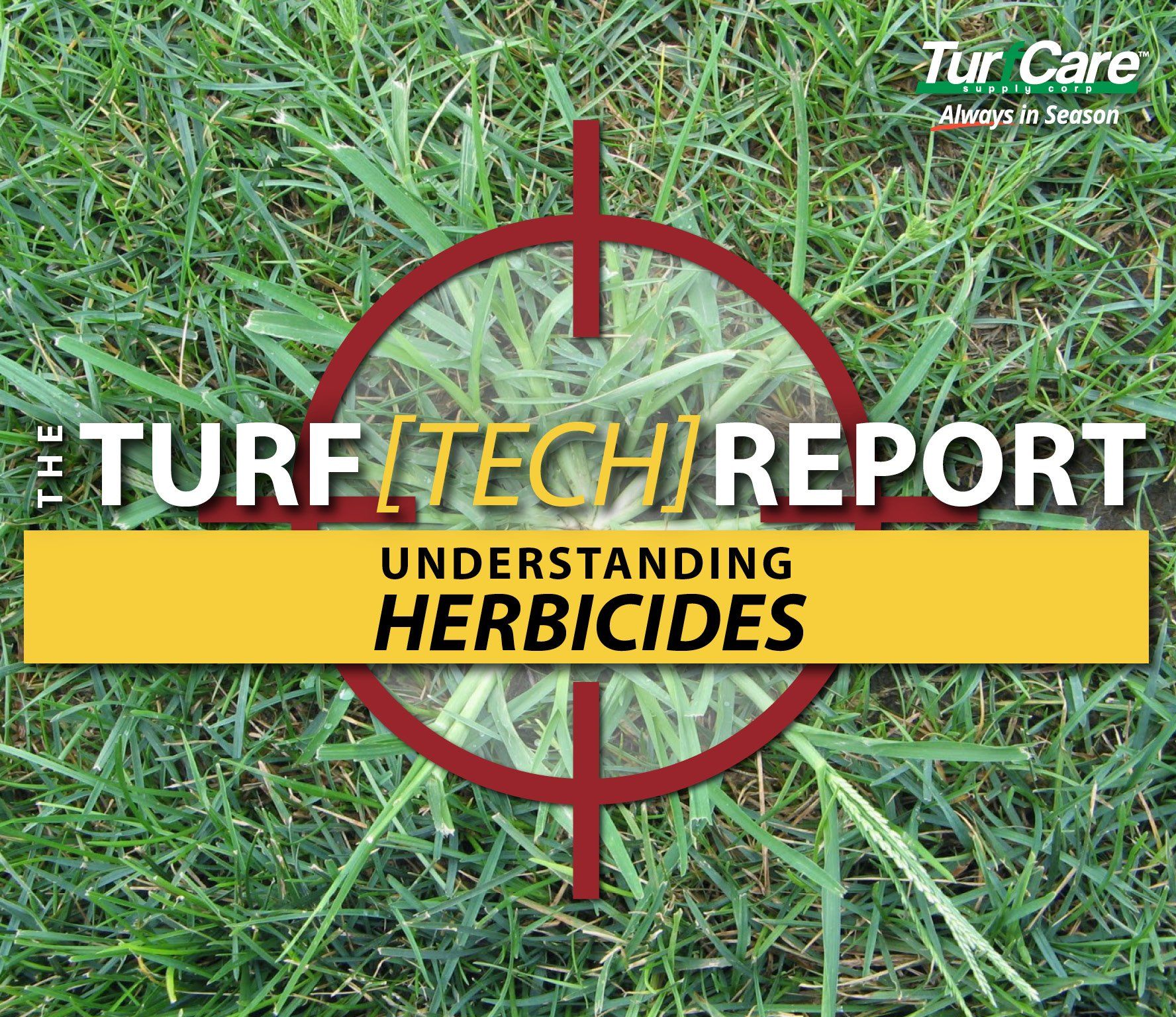The Turf[TECH]Report - Understanding Herbicides

UNDERSTANDING HERBICIDES
The term herbicide, well known by the turf industry for years, are chemicals that can be applied to fertilizer that can kill or change the normal growth of weeds, but do you know the difference between all the herbicides on the market? Because there are a variety of herbicide options available, it’s important to understand them prior to purchase in order target a particular problem and get the results you'r looking for.
THE BASICS OF HERBICIDES
Herbicides will fall into two categories; pre-emergent or post-emergent. As the name alludes, pre-emergent herbicides should be applied prior to weed germination and/or emerging weeds so that it can form a chemical barrier in the soil to protect the turf from infestation. Post-emergent herbicides are applied after the weeds have already germinated and emerging from the soil. Pre-emergent herbicides can be applied as a liquid, a granular or with a fertilizer (combo) and watered into the soil to activate the weed prevention feature. Post-emergent herbicides are usually foliar applied, meaning the chemical must come in contact with leaf or petal and be absorbed by the weeds in order to kill the weed. Often times this is a less effective method because the chemical can be washed off leaves by rainfall or irrigation before it can be absorbed.
On top of being pre- or post-emergent, herbicides can either be, selective and nonselective. Selective herbicides target particular weeds without damaging surround turf or plants, while, non-selective herbicides kill all plants, including turf grass. Non-selective herbicides should be applied to weeds that are actively growing and excessively invading your lawn. Non-selective herbicides are ideal for spot treatment of existing weeds, but caution must be used as desired turf will also be killed.
- TIP: Non-selective herbicides are great to use along an overgrown fence or between the cracks in a driveway and selective herbicides are best to remove weeds within your lawn. A good rule of thumb to remember, if the area is overrun with 50% weeds, a non-selective herbicide may be your best choice, understand though that you will most likely need to reseed.
TIMING IS EVERYTHING
Timing is crucial when applying an herbicide, especially pre-emergents. Pre-emergent need to be applied prior to a weed seed germination; but how does one know when a weed is going to germinate? One must have an understanding of what weed is the persistent issue and learn when and at what temperature it begins to grow in order to prevent the weed from sprouting. Two ways to determine germination is monitoring soil temperatures on site (where you will apply treatment) or with phenology. As SportsField Management Magazine states in their article, “Crabgrass and Goosegrass Control”, phenology is a technique that refers to using temperature as a basis of a predictive method because plant growth and development is based on temperature. This technique can provide useful information to predict weed emergence by monitoring growth patterns in conjunction with calculating degree-day accumulations. It is important to note that when using phenology, the plant does not emerge at a certain degree point but rather at a range of degree-days, for example, crabgrass, a C4 annual grassy weed, germinates in early spring at a temperature around 50-55 degrees. In SportsField Management Magazine’s same article, “Crabgrass and Goosegrass Control”, they bring light to a study done that found that crabgrass germinated within a degree day range of 42-78 degrees. With phenology, one can develop models as a guide to help target pre-emergent herbicide applications in specific region.
- NOTE: Pre-emergents applied after initial weed germination can still provide benefits to prevent additional weeds from emerging, however, the current germinated weeds will most likely mature and not provide desired results. Its recommended to address the problem with a specialty herbicide, like Dimension, that combines both pre-emergent with a post-emergent herbicide if weeds have already germinated.
TYPES OF PRE-EMERGENT AND POST- EMERGENT TECHNOLOGIES
There are many different pre- and post- emergent technologies available. The different technologies can affect the window of application as well as effectiveness. It is important to apply them at the right time and identify which weeds you want to target to get the best results.
PRE-EMERGENTS
- Dimension - Controls 47 grassy and broadleaf weeds, Longer application window
- Atrazine - Recommended for southern regions on St. Augustine Grass and Centipede Grass
- Prodiamine - (Barricade equivalent) is known to be the longest-lasting, and most economical due to lowest application rates.
POST-EMERGENTS
- Lock-Up - Superior efficacy, can be applied anytime of year, can be applied to warm- & cool-season turf.
- Lazer - Contains three key active components, Dicamba, 2-4D, and MCPP. The combination of these three offer effective post control of more than 40 different weeds.
GLOSSARY
- C4 plants - Warm-season; tropical plants that reduce carbon dioxide captured during photosynthesis to useable components by first converting carbon dioxide to oxaloatcetate, a 4-carbon acid
- C3 Plants - Cool-season; temperate plants that reduce (fix) CO2 directly by the enzyme ribulose bisphosphate carboxylase (RUBPcase) in the chloroplast resulting in a reaction between CO2 and ribulose bisphophate, a phosphorylated 5-carbon sugar, forms two molecules of a 3-carbon acid called 3-phosphoglyceric acid
For professional fertilizers, humic and AMP-XC™ enriched products available, please visit TurfCare’s online Product Catalog.
For green industry professionals or others interested in ordering Turfcare products, please contact our Customer Service to find a distributor near you.
The TURFReport Highlights:
Additional Articles and Insights
















